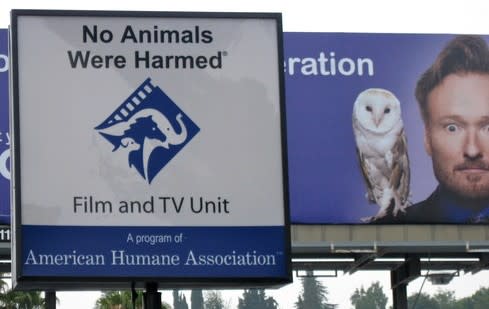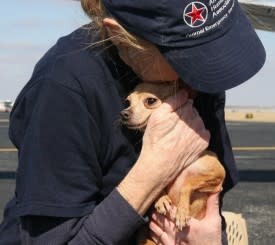AHA’s Animal Film/TV Confab “Productive” Today
Diane Haithman is a Deadline contributor:
UPDATE: The American Humane Association’s planned industry confab took place this morning at the Academy of Television Arts & Sciences to discuss issues surrounding the monitoring of animal action on film and television sets. After the event, AHA spokeswoman Jody Frisch told Deadline the meeting was a “productive exchange of ideas” with total attendance 45-50 people including panelists and guests. One news report claimed only Warner Bros had accepted the invite that went out weeks ago, but Frisch told Deadline that “yes” responses continued coming in early this morning. She confirmed invitees included representatives of “any and all filmed entertainment” but noted “we’d like to see more participation”. The names of the attendees were not made public at the closed-to-the-press roundtable discussion described as “a small private affair” at the Academy’s North Hollywood headquarters. Deadline confirmed that notably absent from the invite list were Hollywood’s professional animal trainers. They have a love-hate relationship with the American Humane Association — the group behind the well-known “No Animals Were Harmed” seal of approval for movies and TV — which oversees their work. Frisch told Deadline trainers were not invited because the event was geared to educate the production side of the industry. But trainers were represented on the panel, however, as part of what Frisch said were “a mix of industry executives, producers, writers and directors along with trainers, veterinarians and AHA representatives”.
The reasons for Wednesday’s meeting? Mostly money. AHA is now solely funded by the nonprofit Industry Advancement and Cooperative Fund overseen by SAG-AFTRA and says it needs more dollars to continue overseeing an explosion in productions worldwide. This despite the fact that more films are using CGI for animal action than in the past. Still, Life Of Pi, for example, used 4 live tigers along with computer-generated ones. In 2002-2003, Frisch said AHA monitored 2,392 days of animal production and issued about 144 certifications. In 2012, the organization monitored about 3,500 days of action and handed out about 570 certifications. Far-flung locations call for more travel than ever before. And the organization has added a veterinary adviser and a scientific committee. “It’s difficult. We’ve grown about 395%, and our grant has really only increase about $600,000 over the last 10 years,” Frisch said.
“When this unit was really up and moving, there were three television networks and a handful of studios, and for the most part they were located in L.A. There was some location shooting certainly, but not anything like it is today. There are hundreds and hundreds of TV channels, websites, production companies. The demands on the film and TV unit have really outgrown the current models of funding and staffing.”
Even with the staff and money shortages, Wednesday’s meeting also planned to discuss whether AHA oversight should extend to include animal housing and training facilities off the set.
With or without high attendance for this meeting, the issue of animal treatment on sets remains an industry hot button. In recent news, HBO’s Luck shut down after 3 horses died on set and was canceled after a 4th horse died. (Further complicating matters, in late December a former executive with AHA’s film unit, Barbara Casey, filed suit against the group and HBO, claiming she was dismissed because she had complained about the working conditions for the animals). Warner Bros’ The Hobbit was also plagued by animal cruelty allegations overseas when 27 animals filmed in the trilogy died at the farm where they housed. Los Angeles-area trainer Sue DiSesso Gordon says one problem is the proliferation of non-union productions including many independent films, reality shows and Internet productions. “AHA is not sent to these productions. But even with union shows there is a shortage of staff. There are just not enough of them to go to every production going on.”
While the Film & Television Unit (now based in Studio City) was not established until 1940, AHA began looking into Hollywood animal safety as early as the 1920s. The all-popular Western was its first target. The AHA has had its detractors over the years, most notably People For The Ethical Treatment of Animals. PETA has frequently complained that AHA hasn’t done enough to protect animals on the set. On the other hand, some trainers claim that AHA tries to exert too much control and fails to respect the skill and compassion of Hollywood’s unionized trainers. Veteran trainer Rob Bloch, founder of Critters of the Cinema of Lake Hughes, said that in 37 years he has had no more than minor criticisms from AHA officials. (One official told him to pick up two puppies at a time, not four. Another admonished him not the tap a Golden Retriever on the nose to get the dog’s attention.) While Bloch supports AHA’s presence on sets, “we just feel the group is supposed to be on set to make sure that animals are treated in a humane fashion. But they want to decide how we train animals.”
Frisch said AHA continues to stress their role as an oversight organization, not an advocacy group. “We are not an activist organization. What we do is based on research and science,” she said. “But the guidelines are indeed a living document. We need to revisit them, and we are asking the industry to come together and meet with us.”
Related stories
TV Academy, Humane Association To Meet Wednesday On Animal Safety
Get more from Deadline.com: Follow us on Twitter, Facebook, Newsletter


